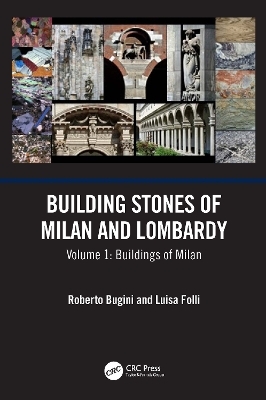
Building Stones of Milan and Lombardy
CRC Press (Verlag)
978-1-032-42064-6 (ISBN)
Milan has played an important role in the Italian country since the Roman period. This importance is reflected also by the diffusion of stone architecture: a persisting trait of Milan architecture was the use of different stones in the same building. Milan lies in the middle of the alluvial plain of the Po, far from the stone quarries; some waterways were dug out in order to supply the building stones from the surrounding territories.
The study of stone as a building material was significant at the end of 19th century, but then it was largely neglected by both architects and geologists. So it is significant to suggest a study about the stones employed to build in Milan (Volume 1) in relationship with a petrographic study about the features of the stones quarried in the whole Lombard territory (Volume 2).
The present volume contains a record of Milanese edifices marking the different historical periods. Each edifice is described in a "card" containing: the building history, the architect, the kind of stone employed and subdivided according to the different parts of the building and the shape of stone elements. A particular investigation is addressed to the stones used during the 20th century; a great part of them were never used before in Milan (or in Lombardy).
Roberto Bugini was born in Milan, Italy, in 1952. He graduated in Scienze Geologiche (geology), University of Milan, in 1976. Since 1983 he has been a researcher of CNR-ICVBC Istituto Conservazione Beni Culturali. He has been a lecturer in stone materials at the Scuola di Specializzazione in Archeologia – Università Cattolica di Milano, since 2009. His fields of interest are stones and mortars used in historic architecture with particular application to the territory of Lombardy (Italy). Luisa Folli was born in Lodi in 1956. She graduated in Scienze Naturali (natural sciences), University of Milan, in 1990. Since 1991 Luisa has worked in the field of stone conservation and has been a teacher (Mineralogy and Petrography) at Scuola di Restauro ENAIP – Percorso quinquennale per Restauratori Beni Culturali (Botticino-Brescia) since 1995. Field of interest: scientific analyses on nature and decay of historic building materials. References: about 150 articles on books, journals and proceedings.
1. Stone architecture in Milan. 2. From piazza Duomo to piazza Fontana. 3. From piazza della Scala to piazza San Babila. 4. From Ca’ Granda to piazza Missori. 5. From Carrobio to Cordusio and piazza Affari. 6. From via Broletto to corso Garibaldi and Brera. 7. From via Manzoni to corso Venezia. 8. From Porta Vittoria to Porta Romana. 9. From corso Italia to Porta Ticinese. 10. Sant’Ambrogio and surroundings. 11. From via Dante to piazza Castello and corso Sempione. 12. North-west Sector. 13. North-east Sector. 14. East Sector. 15. South Sector. 16. West Sector.
| Erscheinungsdatum | 27.03.2023 |
|---|---|
| Zusatzinfo | 2 Halftones, black and white; 2 Illustrations, black and white |
| Verlagsort | London |
| Sprache | englisch |
| Maße | 174 x 246 mm |
| Gewicht | 1160 g |
| Themenwelt | Naturwissenschaften ► Biologie ► Ökologie / Naturschutz |
| Technik ► Architektur | |
| Technik ► Bauwesen | |
| Technik ► Bergbau | |
| Technik ► Umwelttechnik / Biotechnologie | |
| ISBN-10 | 1-032-42064-2 / 1032420642 |
| ISBN-13 | 978-1-032-42064-6 / 9781032420646 |
| Zustand | Neuware |
| Informationen gemäß Produktsicherheitsverordnung (GPSR) | |
| Haben Sie eine Frage zum Produkt? |
aus dem Bereich


